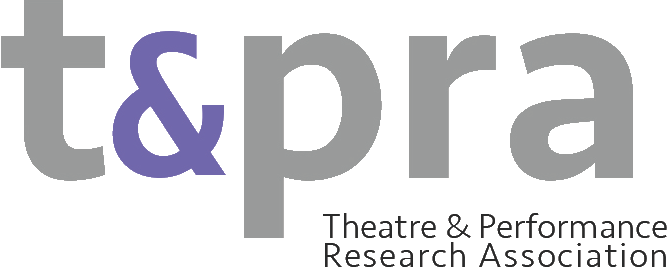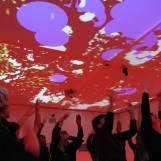Performance and New Technologies 2018
Full Name: Joanne Scott
Annual Conference Theme (if applicable): The Digital Performer and Social Media
What were the main points that emerged from your WG this year?
Performance and New Technologies WG contributors discussed the 2018 theme titled ‘The Digital Performer and Social Media’, looking at different practices such as dance and ballet, durational performance, immersive technologies and performance, live mixing and walking, flash mode, popular performance, storytelling, headphone theatre and applied theatre. The main themes that emerged included:
Optionality and Divided attention
On Wednesday, Tamara Tomic Vajagic introduced us to the concept of FoMO (Fear of Missing Out) to discuss divided attention in metonymic postdramatic spaces with reference to William Forsythe’s ‘Kammer/Kammer’ (2000). The WG revisited the concept of FoMO in several occasions during the sessions. On Thursday, Jo Robinson talked about the ‘Wimbledon effect’ in captioned performances and referred to the concept of FoMO to remind us that in live performance there is always something to lose. Agreeing with this, Mary Oliver talked about creating optionality in theatre and performance and opened questions about performance skills and training.
Live and Mediated: Performance Documentation and Archives
Laura Gemini looked at postdramatic theatre and the case of Frosini/Timpano’s ‘Aldo Morto 54’ (1998), a durational transmedia storytelling performance, to discuss liveness and mediation, arguing that performance documentation and archives can also act as artworks. Andi Johnson talked about the ephemeral and the archival focusing on Twitter and social media as archival spaces for performance documentation. Through a historical analysis of flash mode performance, Rebecca Savory Fuller examined the democratisation of performance documentation as a result of the use of social media and YouTube shifting from the ‘live’ to the ‘mediated’. Jo Scott demonstrated and discussed her live mixing and walking intermedial practices, which present a framed version of the world and allow participants to re-engage with places of attachment and locality. WG discussions focused on intermediality and in-betweeness, crossing from one medium to another, and interdiciplinarity in performance and new technologies practices and research.
Immersive Technologies: Empathy and Inclusiveness
On Thursday, the WG discussions centered around the concepts of ‘empathy’ and ‘inclusiveness’. Discussions focused on the importance of using new technologies in performance to allow voices that are not usually heard to be heard and to give access to people that won’t normally attend theatre. Kristina Gavran talked about her experience on ‘being on someone else’s shoes’ as part of Empathy Museum’s ‘A Mile in My Shoes’ headphone true-life storytelling walk to argue that the art of listening enhanced by touching (use of tangible object) and walking can deepen the experience and create greater empathy. On Friday, Vlad Butucea discussed his experience with Feeling Limbo VR (Guardian VR, 2017) to challenge the notion of empathy, questioning whether someone can really ‘put oneself on someone else’s shoes’ from the safety of their home and especially whilst being able to control the environment and return to a safe ‘reality’ at any point. Liam Jarvis also discussed the use of VR apps and installations to simulate neurodiverse experiences, focusing on his own applied work with Analogue to take up the virtual body of an individual living with Young-Onset Parkinson’s disease in Transports – created in collaboration with Parkinson’s UK and neuroscientist Prof. Narender Ramnani (Royal Holloway University). Jo Robinson focused on the potential of mixed reality to offer new tools for embedding access and inclusion in live performance, referring to her own Integrated Immersive Inclusiveness project, funded through the AHRC/EPSRC’s Next Generation of Immersive Experiences funding call. Focusing on mixed reality captioning technologies, she reported on the technologies emerging from the project ‘hackfest’, and considered emerging questions in relation to access, inclusion and interaction.
Digital Performer Training: Joint Session with Performer Training Working Group
In this session, practices exploring training processes employing digital devices, networks and modes of communication were presented and discussed. A range of intersectional themes and ideas emerged between the Performer Training and Performance and New Technologies working groups, including the ways in which technologies can productively disrupt training processes, but also be disrupted by those very processes. Equally, modes of collaborative training, with technologies emerged through all presentations, challenging the hierarchies of trainer and trained as well as the gaze or way of looking that happens in a studio context between those parties. Distributed agencies within a training process were also discussed, with Anna Makrzanowska focusing on the distinct synergies and agencies produced by the use of a networked mobile device as a ‘bio-object’ in training processes, while Christina Papagiannouli and Sarah Crews reflected on the augmentation of training in the age of the internet and the flattening of hierarchies that are enabled through the distributed usage of networked and social media technologies. Maria Kapsali’s presentation focused on a collaborative training process, enabled through blog posts, which led to reflection on different modes of visibility in training practices, particularly challenging the idea that knowledge is always visible.
Audiencing, modes of reality and the digital performance of humanity
In the final working group session on Friday, questions around audiences and audiencing were brought to the fore through three diverse presentations. C&T practically demo-ed their interactive, learning technology Prospero, though which a ‘digital prompt copy’ of activities, prompts, dialogue and other digital content can be activated to create ‘online interactive dramas’ in a range of spaces. Vlad Butucea was also addressed the positioning and movement of bodies by digital means, through the Guardian VR experience, Feeling Limbo, with a particular focus on the false promise of becoming and movement which is offered in this experience. Finally, Francesco Bentivegna reflected on the absurd performance of humanity on display through conversations between smart speakers and online bots. Rich discussion around digitally displaced or misplaced performance ensued, along with reflections on VR and nomadism, as well as, again, the felt responses, both designed and emergent, that arise from these particular intersections of bodies and digital processes/performances.
What was discussed at your business meeting?
What was discussed at your business meeting?
(1) Jo Scott (JS) and Christina Papagiannouli (CP) thanked Jem Kelly for serving as co-convenor and for all the good work he has done and invited WG members interested in the role to put themselves forward.
ACTION: WG members to contact CP/JS to discuss their interest in the role by the end of September.
(2) CP and JS summarized the themes that emerged from the 2018 sessions. They proposed the next conference’s theme to focus on inclusiveness and different modes of engagement, interaction and discomfort in performance and new technologies with working title ‘Inclusive Intermediality’.
(3) Following on from 2017 interim event’s practice-based focus on telematics performance and based on 2018 TaPRA WG’s interest on immersive technologies, CP proposed to organize an interim event at the University of South Wales (Cardiff) on VR/AR/MR performance practices. There was discussion about the preferred period and date for the interim event. JS reminded the WG members about the forthcoming special issue on Performance and VR Practice from The International Journal of Performance Arts and Digital Media.
ACTION: CP to organize interim event on Immersive and Interactive Technologies at the University of South Wales (Cardiff) before Easter.
(4) JS and CP expressed their interest in submitting a proposal for a special issue for The International Journal of Performance Arts and Digital Media to include papers and discussions presented at WG events over a period of 3 years.
ACTION: JS and CP to submit a proposal by the end of 2018.
(5) Communication/FB: CP and JS reiterated that the main mode of communication for the working group is through the TaPRA website and working group Facebook page, as well as the TaPRA email address.
(6) TaPRA Prize Judges: CP and JS shared the call for working group members to participate in the judging process for the TaPRA prizes and invited any expressions of interest by 1st October
ACTION: WG members to submit expressions of interest to CP/JS to discuss by the end of September.
Types of contributions:
Paper presentations, provocations, lecture-demo and practical-demo.
Number of formal contributors (those listed in book of abstracts) 17
Approx. overall number of delegates who attended your WG Sessions 17-25, with joint panel attracting over 30 delegates
Composition of WG (PG, ECR, etc.)
The Performance and New Technologies WG members are from all career levels. In 2018, the WG was comprised by one applied theatre company, five PGRs, four ECRs and eight mid-career and senior researchers. One of the WG members presented as part of TaPRA Gallery sessions. Due to personal reasons, 2 of the contributors did not manage to attend the conference.
Did you have any non-UK participants? Yes
If your WG hosted an Open Panel, do you have any feedback?
The open panel was well attended and resulted in rich discussions around access, inclusion and opportunities for those skilled in performance making to work in diverse fields, as well as whether digitally enabled ‘body-swapping’, through VR experiences, can ever allow us to inhabit the ‘irreducible alterity of the other’ and the ethical implications of efforts to do so.
Any additional points or feedback not covered above?
The Performance and New Technologies WG attracts a number of international participants. This year we had participants from Italy and the United States.
The Joint panel with Performer Training was a particularly well attended and rich panel, leading to further consideration as to how the working group can intersect with other working groups to explore intersecting ideas and concerns across our areas.

